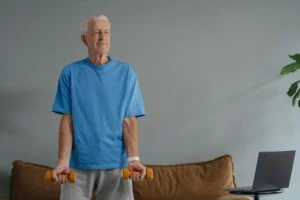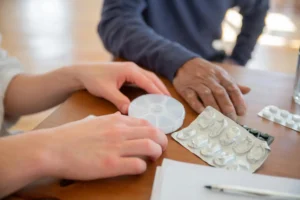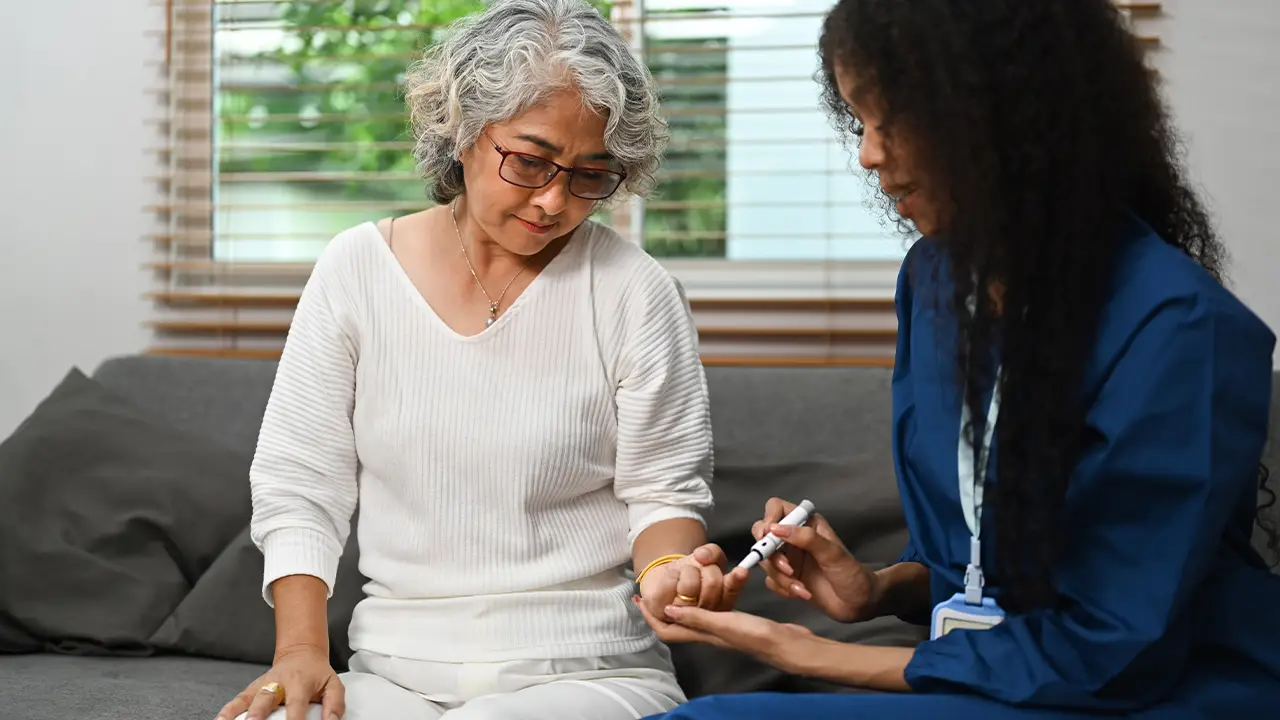At 72, Robert had been managing his Type 2 diabetes well for over a decade. But after his wife passed away last spring, everything changed. Without her gentle reminders about medication timing and healthy meals, Robert found himself skipping insulin doses, eating irregular meals, and struggling to keep his blood sugar stable. His daughter, living across Calgary, worried constantly about his diabetes management while he lived alone.
Robert’s story reflects a challenge facing thousands of Calgary seniors: maintaining effective diabetes care when aging brings new obstacles to daily management.
If you’re caring for an aging parent with diabetes, or you’re a senior managing diabetes yourself, you’re not alone. According to Diabetes Canada, over 30% of Calgary seniors live with some form of diabetes, making it one of the most common chronic conditions affecting older adults in our community. The good news? With proper planning, support, and sometimes professional assistance, seniors can successfully manage diabetes at home while maintaining their independence and quality of life.
This comprehensive guide will walk you through everything families need to know about managing diabetes in elderly adults at home. From recognizing warning signs and preventing complications to creating effective daily routines and knowing when to seek additional support, we’ll cover the essential strategies that keep diabetic seniors healthy and safe.
Understanding Diabetes in Older Adults
Types of Diabetes Affecting Calgary Seniors
Type 2 Diabetes represents the vast majority of diabetes cases among seniors, accounting for roughly 90% of diagnoses in older adults. This form develops when the body becomes resistant to insulin or doesn’t produce enough insulin effectively. Many Calgary seniors develop Type 2 diabetes later in life due to factors like decreased physical activity, weight gain, and natural aging processes that affect insulin sensitivity.
Type 1 Diabetes in seniors typically represents long-term management rather than new diagnosis. Seniors who have lived with Type 1 diabetes for decades face unique challenges as aging affects their ability to recognize symptoms and maintain precise blood sugar control.
Gestational diabetes complications can sometimes evolve into Type 2 diabetes later in life, particularly affecting senior women who experienced gestational diabetes during pregnancies years earlier.
How Aging Affects Diabetes Management
Physical changes that impact blood sugar control:
As we age, our bodies process glucose differently. Seniors often experience decreased kidney function, which affects how the body eliminates excess glucose and diabetes medications. Reduced muscle mass, common in aging, also decreases the body’s ability to utilize glucose effectively, making blood sugar management more challenging.
Vision changes associated with aging can make it difficult for seniors to accurately read blood glucose meters, measure insulin doses, or recognize visual symptoms of blood sugar fluctuations. These changes require adaptations in diabetes management approaches.
Cognitive considerations in senior diabetes care:
Memory issues, even mild ones, can significantly impact diabetes management. Seniors may forget medication doses, meal timing, or blood sugar testing schedules. More concerning, cognitive changes can affect a senior’s ability to recognize and respond appropriately to dangerous blood sugar episodes.
Medication absorption and effectiveness changes:
Aging affects how the body absorbs and processes medications. Seniors may require different insulin types, adjusted doses, or modified timing compared to their younger years. Additionally, many seniors take multiple medications, increasing the risk of drug interactions that can affect blood sugar control.
Daily Diabetes Management for Seniors at Home
Blood Sugar Monitoring Best Practices for Elderly Diabetics
Choosing senior-friendly glucose monitoring devices:
Modern glucose meters offer features specifically helpful for seniors managing diabetes at home. Look for devices with large, easy-to-read displays, simple one-button operation, and audio capabilities for seniors with vision challenges. Some meters store previous readings and can share data with family members or healthcare providers.
Continuous glucose monitors (CGMs) are becoming increasingly popular among seniors because they reduce the need for frequent finger pricks while providing real-time blood sugar information. Many Calgary seniors find CGMs especially helpful because they can alert caregivers or family members to dangerous blood sugar levels even when the senior doesn’t recognize symptoms.
Establishing consistent testing routines:
Successful diabetes management requires regular blood sugar monitoring, but seniors often struggle with remembering when to test. Create visual reminders and link testing to daily activities that already happen consistently, such as meals or morning routines.
For seniors living independently, consider testing schedules that align with natural energy levels. Many find morning testing easier when they’re most alert, while others prefer pre-meal testing because it connects directly to food decisions.
Recording and tracking blood sugar patterns:
Blood sugar logs help identify patterns that inform treatment decisions. Choose logging methods that match your senior’s abilities—some prefer traditional paper logs, while others embrace smartphone apps or digital tracking systems.
Share blood sugar records with healthcare providers regularly, and consider systems that allow family members to monitor trends remotely. This collaboration helps catch concerning patterns early and provides peace of mind for families worried about seniors managing diabetes alone.
Medication Management for Diabetic Seniors
Insulin administration safety at home:
Proper insulin storage becomes crucial for seniors managing diabetes independently. Insulin should be stored in the refrigerator but never frozen, and in-use vials can be kept at room temperature for up to 28 days. Seniors should mark opening dates on insulin vials and dispose of expired medication properly.
For seniors with dexterity challenges, consider insulin pens instead of traditional vials and syringes. Insulin pens offer easier handling, pre-measured doses, and reduced risk of dosing errors. Some pens also have memory functions that record the time and amount of the last injection.
Oral diabetes medication considerations:
Many seniors take multiple oral medications for diabetes management, each with specific timing requirements. Pill organizers with time-of-day compartments help prevent missed doses and dangerous double-dosing. Choose organizers with large compartments and clear labeling.
Some diabetes medications interact with common senior medications, particularly blood pressure drugs and heart medications. Regular medication reviews with pharmacists or healthcare providers help identify potential interactions and optimize treatment regimens.
Managing multiple medications safely:
Polypharmacy—taking multiple medications simultaneously—is common among diabetic seniors and increases complexity in diabetes management. Create comprehensive medication lists that include prescription drugs, over-the-counter medications, and supplements, as all can affect blood sugar levels.
Consider medication synchronization programs offered by many Calgary pharmacies, where all monthly medications are filled on the same day. This simplifies pickup schedules and makes it easier to track medication adherence.
Nutrition and Meal Planning for Senior Diabetics
Creating Diabetes-Friendly Meal Plans for Elderly Adults
Understanding carbohydrate counting for seniors:
Carbohydrate counting remains the cornerstone of diabetes meal planning, but seniors often find traditional counting methods confusing or overwhelming. Simplified approaches, such as the “plate method,” can be more practical for everyday use.
The plate method divides each meal into sections: half the plate with non-starchy vegetables, one quarter with lean protein, and one quarter with carbohydrate-rich foods. This visual approach eliminates complex calculations while maintaining good blood sugar control.
Meal timing strategies for stable blood sugar:
Consistent meal timing helps maintain stable blood sugar levels throughout the day. Seniors managing diabetes should aim to eat main meals at roughly the same times daily, with planned snacks if recommended by their healthcare provider.
For seniors taking insulin, meal timing becomes even more critical. Rapid-acting insulin requires coordination with meals, while long-acting insulin provides background coverage throughout the day. Understanding these timing relationships prevents dangerous blood sugar fluctuations.
Calgary senior-specific nutritional considerations:
Calgary’s seasonal variations affect food availability and senior eating patterns. Winter months may limit fresh produce access and reduce physical activity, potentially affecting blood sugar control. Plan for seasonal menu adjustments and consider how weather impacts grocery shopping and meal preparation.
Many Calgary seniors on fixed incomes worry about the cost of diabetes-friendly foods. Fortunately, many nutritious options—such as eggs, canned fish, frozen vegetables, and whole grains—are both affordable and blood sugar-friendly.
Meal Preparation Solutions for Diabetic Seniors
Easy meal prep strategies:
Batch cooking and meal preparation can simplify daily nutrition management for seniors with diabetes. Prepare large portions of diabetes-friendly meals and freeze individual servings for easy reheating throughout the week.
Focus on simple, one-pot meals that combine protein, vegetables, and appropriate carbohydrates. Slow cooker meals, sheet pan dinners, and freezer-friendly casseroles provide nutritious options without daily cooking stress.
When cooking becomes challenging:
Some seniors develop physical limitations that make meal preparation difficult. Adaptive kitchen tools, such as ergonomic can openers, lightweight cookware, and easy-grip utensils, can help maintain cooking independence longer.
Meal delivery services specifically designed for diabetic seniors are becoming more available in Calgary. These services provide portion-controlled, nutritionally balanced meals that take the guesswork out of diabetes meal planning.
Exercise and Physical Activity for Diabetic Seniors
Safe Exercise Programs for Senior Diabetes Management
Low-impact activities that improve blood sugar control:
Regular physical activity significantly improves blood sugar control in seniors with diabetes, but exercise programs must account for age-related physical limitations and safety concerns.
Walking remains one of the most effective and accessible forms of exercise for diabetic seniors. Start with short distances and gradually increase duration and frequency. Calgary’s extensive pathway system provides excellent walking opportunities year-round, with many indoor alternatives during harsh weather.
Swimming and water aerobics offer excellent low-impact exercise options that are gentle on aging joints while providing cardiovascular benefits. Many Calgary recreation centers offer senior-specific aqua fitness programs designed for older adults with chronic conditions.
Chair exercises for seniors with mobility limitations:
Seniors with significant mobility challenges can still benefit from regular physical activity. Chair-based exercises can improve circulation, maintain muscle strength, and help with blood sugar management.
Simple arm circles, seated marching, and resistance band exercises can be performed safely at home. Many Calgary senior centers offer chair yoga or seated fitness classes specifically designed for older adults with health conditions.
Exercise Safety Considerations for Diabetic Seniors
Preventing exercise-related blood sugar complications:
Exercise affects blood sugar levels, sometimes unpredictably. Seniors should check blood sugar before, during (for longer activities), and after exercise to understand their individual responses to physical activity.
Keep fast-acting carbohydrates readily available during exercise in case blood sugar drops too low. Glucose tablets, juice boxes, or hard candies can quickly treat hypoglycemia during physical activity.
Coordinating exercise with medication and meals:
The timing of exercise in relation to meals and medications affects blood sugar response. Generally, exercising 1-2 hours after meals can help control post-meal blood sugar spikes, but individual responses vary.
Seniors taking insulin may need to adjust doses on more active days. Work with healthcare providers to develop exercise plans that account for medication timing and individual blood sugar patterns.
Recognizing and Managing Diabetes Complications at Home
Warning Signs Every Senior and Family Should Know
Hypoglycemia (low blood sugar) symptoms in elderly adults:
Low blood sugar can be particularly dangerous for seniors because aging can diminish the body’s typical warning signals. While younger adults might feel shaky, sweaty, or anxious when blood sugar drops, seniors may experience confusion, dizziness, or sudden weakness as primary symptoms.
Severe hypoglycemia can mimic stroke symptoms in seniors, including slurred speech, unsteady walking, or sudden personality changes. Family members should learn to recognize these signs and respond quickly with appropriate treatment.
Hyperglycemia (high blood sugar) recognition:
High blood sugar often develops gradually, making it harder to recognize than sudden low blood sugar episodes. Seniors may experience increased thirst, frequent urination, fatigue, or blurred vision as blood sugar rises.
Persistent high blood sugar can lead to serious complications including diabetic ketoacidosis or hyperosmolar hyperglycemic state, both medical emergencies requiring immediate attention.
Emergency Response Plans for Diabetic Seniors
Creating action plans for blood sugar emergencies:
Every senior managing diabetes at home should have written emergency action plans for both high and low blood sugar episodes. These plans should include specific blood sugar thresholds that trigger action, step-by-step treatment instructions, and emergency contact information.
Post emergency action plans in visible locations throughout the home, and ensure family members, neighbors, and caregivers understand the procedures. Include information about emergency medications, preferred hospitals, and healthcare provider contact information.
When to call 911 vs. when to call healthcare providers:
Severe hypoglycemia that doesn’t respond to treatment within 15 minutes requires emergency medical attention. Similarly, blood sugar levels above 400 mg/dL, especially with symptoms like vomiting or difficulty breathing, constitute medical emergencies.
Less severe but concerning situations—such as persistent high blood sugar, unusual symptoms, or difficulty managing routine care—warrant calls to healthcare providers for guidance and possible appointment scheduling.
Technology and Tools for Senior Diabetes Management
Digital Health Solutions for Elderly Diabetics
Smartphone apps and diabetes management tools:
Modern smartphone applications can simplify diabetes management for tech-savvy seniors. Apps that track blood sugar, log meals, and remind about medication timing can improve management consistency.
However, many seniors find complex apps overwhelming. Choose applications with large fonts, simple interfaces, and minimal features rather than comprehensive programs with multiple functions.
Remote monitoring systems for family peace of mind:
Continuous glucose monitors and smartphone-connected blood glucose meters can share data with family members in real-time. This technology allows adult children to monitor their parent’s blood sugar trends without being intrusive about daily management.
Some systems send alerts to designated family members when blood sugar levels become dangerously high or low, providing crucial safety nets for seniors living independently.
Traditional Tools That Still Work Best
Paper logging systems and visual aids:
Not every senior embraces digital technology, and traditional paper-based systems remain highly effective for diabetes management. Large-print blood sugar logs, medication charts, and meal planning templates can be just as effective as digital alternatives.
Visual aids, such as portion size guides, carbohydrate counting cards, and symptom recognition charts, provide quick references that don’t require batteries or technical knowledge.
When Professional Home Care Becomes Necessary
Recognizing the Need for Additional Support
Signs that diabetes management is becoming overwhelming:
Multiple episodes of severe high or low blood sugar may indicate that current management strategies aren’t sufficient. Frequent emergency room visits, recurring diabetic complications, or inability to maintain routine care tasks suggest that additional support could improve outcomes.
Social isolation can also worsen diabetes management. Seniors who stop participating in activities they enjoy, avoid social situations, or seem overwhelmed by daily care requirements may benefit from professional assistance.
How home care providers support diabetic seniors:
Professional caregivers trained in diabetes management can assist with blood sugar monitoring, medication administration, meal preparation, and exercise supervision. This support allows seniors to maintain independence while ensuring consistent, proper diabetes care.
Caregivers can also provide crucial safety monitoring, recognizing early signs of blood sugar problems and responding appropriately. For families concerned about diabetic seniors living alone, professional care provides peace of mind and professional expertise.
Types of Professional Diabetes Care Support
Medical home care for complex diabetes management:
Some seniors require nursing-level care due to complex insulin regimens, wound care needs, or frequent blood sugar instability. Registered nurses can provide advanced diabetes management, coordinate with healthcare providers, and manage multiple chronic conditions simultaneously.
Companion care for diabetes support:
Not all seniors need medical-level care but may benefit from companionship and light assistance. Companion caregivers can help with meal preparation, provide medication reminders, accompany seniors to medical appointments, and offer social interaction that supports overall wellbeing.
Respite care for family caregivers:
Family members providing diabetes care can experience burnout and stress. Respite care services give family caregivers breaks while ensuring continued diabetes management and safety supervision.
Building Your Diabetes Management Team
Healthcare Provider Coordination
Regular monitoring and appointment scheduling:
Successful diabetes management requires regular healthcare provider visits, typically every three to six months for routine monitoring. Seniors should see their primary care physician, endocrinologist (if applicable), eye doctor, and podiatrist regularly to prevent and manage complications.
Coordinate appointments to avoid overwhelming schedules while ensuring consistent monitoring. Some Calgary healthcare providers offer senior-friendly scheduling options, such as longer appointment times or same-day multiple specialist visits.
Pharmacy partnerships for medication management:
Develop relationships with pharmacists who understand senior diabetes management challenges. Many Calgary pharmacies offer medication synchronization, adherence monitoring, and regular medication reviews that can improve diabetes outcomes.
Some pharmacists provide diabetes education and can adjust medication timing or formulations to better suit senior lifestyles and capabilities.
Family and Community Support Networks
Educating family members about diabetes care:
Family members should understand basic diabetes management, including how to recognize and treat low blood sugar episodes. Consider attending diabetes education classes together or arranging family meetings with healthcare providers to discuss care plans and emergency procedures.
Calgary community resources for diabetic seniors:
The Calgary chapter of Diabetes Canada offers education programs, support groups, and resources specifically designed for seniors managing diabetes. Many Calgary community centers also provide diabetes-friendly fitness programs and social activities.
Senior-specific diabetes support groups provide opportunities for peer learning and social connection, both crucial for successful long-term diabetes management.
Preventing Long-term Diabetes Complications
Foot Care and Vision Protection
Daily foot care routines for diabetic seniors:
Diabetes can cause nerve damage and poor circulation that make foot injuries dangerous for seniors. Establish daily foot inspection routines, checking for cuts, blisters, swelling, or color changes that might indicate problems.
Choose proper footwear with good support, cushioning, and protection. Never walk barefoot, even indoors, and avoid tight shoes or socks that restrict circulation.
Eye health monitoring and protection:
Diabetes increases the risk of serious eye conditions, including diabetic retinopathy, glaucoma, and cataracts. Schedule annual comprehensive eye exams with eye care professionals experienced in diabetic eye disease.
Report vision changes immediately, including blurry vision, floaters, flashing lights, or dark areas in vision. Early detection and treatment can prevent serious vision loss.
Heart Health and Kidney Protection
Cardiovascular risk management for diabetic seniors:
Diabetes significantly increases cardiovascular disease risk, making heart health monitoring crucial for seniors. Control blood pressure, maintain healthy cholesterol levels, and avoid smoking to reduce heart disease risk.
Regular cardiovascular screening, including blood pressure monitoring and cholesterol testing, helps detect problems early when treatment is most effective.
Kidney function monitoring and protection:
Diabetes can damage kidneys over time, potentially leading to kidney failure requiring dialysis or transplant. Regular urine and blood tests monitor kidney function and detect early signs of diabetic kidney disease.
Maintain good blood sugar control, manage blood pressure, and stay properly hydrated to protect kidney health. Avoid medications that can further damage kidneys unless specifically prescribed for diabetes management.
Financial Planning for Senior Diabetes Care
Understanding Healthcare Costs and Coverage
Alberta Health Services coverage for diabetes supplies:
Alberta Health Services covers many diabetes management supplies, including blood glucose test strips, insulin, and some glucose meters. Understanding coverage limits and requirements helps seniors budget for diabetes care expenses.
Some supplies require prior authorization or have quantity limits. Work with healthcare providers and pharmacists to maximize coverage benefits and minimize out-of-pocket expenses.
Private insurance and supplemental coverage options:
Many seniors have supplemental health insurance that covers diabetes supplies not covered by provincial health plans. Review insurance benefits annually to understand coverage changes and maximize available benefits.
Consider the costs and benefits of upgrading to more comprehensive coverage if diabetes management expenses become significant.
Budgeting for Long-term Diabetes Management
Planning for progressive care needs:
Diabetes management costs may increase over time as health needs become more complex. Budget for potential future expenses, including professional care services, advanced medical equipment, and increased medication needs.
Consider how aging and potential disability might affect diabetes management costs and plan accordingly for long-term financial sustainability.
Conclusion: Successful Diabetes Management at Home
Managing diabetes as a senior, or caring for an aging parent with diabetes, presents unique challenges that require thoughtful planning, consistent execution, and appropriate support systems. But as Robert’s story shows us, with the right approach, seniors can successfully manage diabetes at home while maintaining independence and quality of life.
Six months after recognizing that he needed help, Robert now works with a companion caregiver twice a week who helps with meal preparation and provides gentle reminders about diabetes management tasks. His blood sugar control has improved dramatically, and he’s regained confidence in managing his condition. Most importantly, his daughter no longer worries constantly about his safety and wellbeing.
Key strategies for successful senior diabetes management at home:
Consistency forms the foundation of good diabetes management. Establish regular routines for blood sugar testing, medication administration, meals, and physical activity. These predictable patterns make diabetes management less overwhelming and more effective.
Safety must be the top priority. Ensure seniors and family members can recognize and respond to diabetes emergencies. Have clear action plans, emergency supplies, and communication systems in place.
Support systems make the difference between struggling and thriving with diabetes. Whether through family involvement, community resources, or professional care services, no senior should manage diabetes in isolation.
Technology can help, but it shouldn’t complicate care. Choose tools and systems that genuinely improve diabetes management without creating additional stress or confusion.
Professional help should be considered proactively, not reactively. Early involvement of professional caregivers, educators, or healthcare providers often prevents crises and improves outcomes.
Remember that diabetes management evolves with age. What worked well at 65 may need adjustment at 75 or 85. Regular reassessment of management strategies, safety measures, and support needs ensures that diabetes care continues to meet changing needs effectively.
The goal isn’t perfect diabetes control—it’s safe, sustainable management that allows seniors to continue enjoying their lives while maintaining their health. With proper planning, appropriate support, and consistent care, seniors with diabetes can continue living independently and safely in their own homes for years to come.
If your family is struggling with senior diabetes management, or if you’d like professional assessment of diabetes care needs, don’t hesitate to seek support. At Compassion Senior Care, our caregivers are trained in diabetes management and understand the unique challenges seniors face in managing this complex condition at home.
Need help managing diabetes care for your Calgary senior? Contact Compassion Senior Care today for a free consultation. Our experienced caregivers provide specialized diabetes support that helps seniors maintain independence while ensuring safe, effective diabetes management at home.












